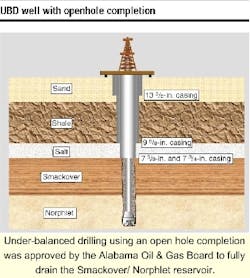UNDER-BALANCED DRILLING: Under-balanced drilling to limits brings old field back to life
C.P. Labat
D.J. Benoit
P.R. Vining
Texaco E & P Co.
Under-balanced drilling along the Gulf Coast, offshore and onshore, has brought life to new and old fields. The success of this particular project has generated new interest in an old asset with a four-fold increase in production including a safe and successful operation. Four Star Oil & Gas, a subsidiary of Texaco operates the Hatter's Pond field 19 miles north of Mobile, Alabama.
Discovered in 1974, the field has produced in excess of 210 bcf of gas and 50 million bbl of condensate and natural gas liquids. This north-south anticline produces from two Upper Jurassic formations. The Smackover, a shallow marine dolomite, occurs at depths ranging from 18,000 ft to 18,300 ft, and is 15-150 ft thick throughout the field.
The underlying Norphlet, aeolian sand dune sandstone, is 0-300 ft thick. The 100-150 ft thick Buckner Salt, overlying the Smackover, along with the eastern boundary (the western fault of the Mobile Graben) form the trapping mechanism that creates the reservoir. The areal extent of the field is 1 mile wide by 5 miles long. Reservoir porosity is 12-15% and permeability averages 2 to 3 md. With bottom hole temperature at 350 degrees F and hydrogen sulfide concentrations of 100-700 ppm, the formations present formidable obstacles for both drilling and production.
Gas drive failing
The aging depletion drive reservoir has seen average bottom hole pressures (BHP) drop from an initial 9,200 psi to the present day 2,700 psi. Originally, gas injection wells were used to maintain BHP, thereby maximizing condensate recovery. The field has reached the blowdown phase, and all producible hydrocarbons are being extracted. The typical well presently produces 3 to 6 MMcf/d and 100-400 b/d condensate through a 5-1/2 in. production liner/tieback.
Based on reservoir modeling, the asset team investigated possibilities for sidetracks and new-drill candidates. With stringent economic constraints, the drilling team worked closely with the asset team in preparing cost estimates that might yield consideration. Due to low BHP (2.9 ppg EMW), previous wells drilled with conventional drilling fluids experienced considerable fluid losses. This fluid invasion also resulted in formation damage, contributing to low flow rates from completions. Consequently, conventionally drilled wells showed little potential.
UBD solution
The drilling team looked for technology that would solve the problem and found that underbalanced drilling (UBD) with foam or gas could mitigate the aforementioned difficulties. The prospect of drilling these formations in an underbalanced state, where reservoir fluids are made to flow into the wellbore, generated much interest. The idea of executing an openhole completion to maximize surface area for flow was proposed with high expectations.
However, while in the planning stage, this idea presented an entirely new set of problems. The drilling team had limited experience with UBD and no experience with gas drilling. Also, the Alabama State Oil & Gas Board needed to allow exceptions to State Rules for the project to be implemented. Both of these issues were met, and UBD was safely and successfully performed. The results created interest in this mature asset.
UBD, although not a new technology, has seen wider acceptance and rapid technological improvements in the past 10 years. This underscores the opportunities that it creates for drilling new and depleted fields. The most significant development has been improvement to the rotating seal that allows for drilling with pressure on the annulus.
There are several rotating head blowout preventer products on the market to accommodate a wide variety of applications. A good level of competition exists among UBD service providers, and that, coupled with increasing utilization, fuels the improvements and the proliferation of knowledge in this subject.
This pool of expertise was tapped to determine if the field proved a viable candidate for UBD. Upon initial discussions, it quickly became evident that the field was an ideal candidate. Preliminary design determined liquid and foam drilling fluids would not satisfy the underbalanced requirements. Low-density fluids could not achieve the underbalanced state required, and foam stability at the high temperatures was questionable. The fluid of choice was gas - either nitrogen or natural gas.
UBD contractors educated the drilling team on available technology. Equipment specifications were reviewed, and a rotating control head was selected. The head utilized two seals and had the ability to change out seal elements without the need to be completely disassembled. The well could be shut-in and the seals replaced through the rotary table.
The rotating head supplier also provided all other UBD equipment and services. The head, flowlines, manifold, four-stage separator, and pump unit came from a single company, which simplified the process. This eliminated any confusion with services or compatibility and allowed the team to focus on design implementation.
The Smackover and Norphlet were the only zones drilled underbalanced. Nitrogen or natural gas was misted with diesel for bit cooling and lubrication. Drilling parameters were designed with simulation and injection rates determined for proper hole cleaning. A model, based on string design, calculated available overpull and torque, while rigorous drillstring inspection ensured the satisfaction of model criteria.
Regulatory modifications
The first matter to overcome was the Alabama Oil & Gas Board rules, which did not allow for UBD or openhole completions. The state rules required the use of a drilling fluid that is sufficient to contain the reservoir pressure and for production casing to be run and cemented through the production interval. A special hearing of the Alabama Oil & Gas Board was convened on Jan. 7, 1998, wherein engineers presented the history of the field, current reservoir pressures, recent drilling and completion results, and the potential impact UBD and completing openhole would have on the field.
Also, the equipment layout, operational aspects including safety plans, and credentials of the UBD supervisor were submitted for review. At this point, an order was granted allowing for the UBD and openhole completion. The initial order allowed for the use of nitrogen or natural gas as the drilling fluid.
Safety was the number one priority. Detailed hazard identification (HAZID) and hazardous operations (HAZOP) plans were constructed. The gas plant's site safety contractor was selected with HAZOP procedures already in place. They provided for monitoring of all gas levels at the rig site and assured all personnel on location were hydrogen sulfide trained. "Breakthrough" meetings, where best practices evolved, were held frequently with the UBD contractor and consultants, site safety supplier, drilling contractor representatives, and field supervisors to cover all aspects of the operation. Rig crews met to discuss operational procedures, equipment, and safe practices.
Implementation
The first well, HP U10-11 #3 stk, chosen for the project was a sidetrack. The plan was to conventionally drill through the Buckner salt, set a liner and tieback to the base of salt, rig up UBD equipment, displace the well with nitrogen and UBD the Smackover and Norphlet.
A rig that had a kelly drive and a 30 ft substructure was mobilized into the field during the summer of 1998. The operation began by milling a window in the 9-5/8 in. casing at 16,437 ft into an anhydrite formation above the salt. A water based mud (WBM) was used to drill an 8-3/8 in. hole into the salt at 17,515 ft and to stop just below the salt at 17,822 ft.
Due to the plastic nature of the salt, the program called for pulling out of the hole and running a 7-3/4 in. liner. With the top of liner (TOL) at 15,355 ft, cementing was performed with full returns. One trip was made to dress off the TOL and the 5 in. drillpipe (DP) was laid down while coming out of the hole.
A 3-1/2 in. by 2-7/8 in. tapered string was picked up and used to polish the TOL and displace the well with 8.4 ppg water. All tests indicated good integrity with the TOL. The liner tieback was then run and cemented in place with full returns. A 6-1/2 in. bit was used to drill out the cement at the TOL, and another set of tests showed good integrity.
The next operation was to install the rotating head and test all BOP, choke, and UBD equipment with nitrogen. However, since this was an existing well, the wellhead was not plumb with the rig, and the BOP stack was not perfectly straight. Even with a 30-ft substructure, horizontal loading of the rotating head seals would be required due to the close proximity of the kelly bushings and rotating elements (less than 6 ft). This necessitated the installation of a shaved flange to level the stack.
All underbalanced equipment, flare lines, and third party equipment was installed and tested with low and high nitrogen pressure. A safety meeting was conducted to review HAZOP and assure complete safety compliance.
Under-balanced operation
To ensure no flow of gas could come up the DP, two float valves were placed at the bit and an additional one 150 ft below the rotary while running in the hole with a 6 in. thermally stable polycrystalline (TSP) bit. The plan called for displacing the water in the well with nitrogen at 4,000-ft increments to minimize surface pressures. At 15,316 ft, the bit tagged, and water was re-introduced to the well. Another mill run cleared the obstruction (TOL seal area), the rotating head was retested, and nitrogen displacement was repeated.
UBD operations began by pumping 1,500 cf/min nitrogen and 10 gpm diesel with 800 psi injection pressure. Some injection pressure increases were noted as ineffective cuttings removal. Increasing the injection to 3,000 cf/min and 30 gpm solved the problem. Penetration rates (ROP) of 4-8 ft/hr were encountered, with a total of 262 ft drilled in 52.5 rotating hours. The entire UBD operation lasted 5 days. The six rotating seal failures, replacement, and the circulating time to check for packing-off contributed to the non-rotating time.
While drilling, the well flowed 8.8 MMcf/d and 22.7 bbl/hr of condensate with a trace of water. The drillstring was then stripped out of the hole and 2-7/8 in. tubing run to 17,674 ft. The tubing is used to inject corrosion inhibitor, and production is up the annulus.
Lessons learned
The well demonstrated that UBD could be done safely and effectively in this environment. Much was learned from the first job, and many improvements were made for the second attempt.
The ability to drill safely with gas was evident; however, the nitrogen cost was substantial. With the inclusion of some additional safety precautions, natural gas (with nitrogen on standby for backup) would prove to be more economical. The field gas plant could supply the natural gas that the operation required at very low cost.
To improve safety, all involved decided that shear rams should be installed before introducing natural gas. Also, to minimize connections and reduce lateral forces on the rotating seal, a topdrive would be installed prior to going underbalanced.
The rotating head had a valve to bleed off pressure between the energized lower seal and the top cup seal, but no means for monitoring this pressure. This void space could trap pressure if the lower energized (primary) seal failed, while the upper seal remained effective. A gauge was installed to detect pressure changes in the void resulting from a seal leakage.
Root cause analysis identified two sources for the seal failures. The imposed lateral forces from the misaligned BOP-kelly configuration were to be solved by drilling with a topdrive (no kelly bushings) and spudding a new well. The use of a topdrive also meant that a kelly hex did not have to pass through the rotating element. Although the element is rated to withstand non-round joints, the change minimized the loading.
The second problem was found in the manufacturing of the rotating seal elements. The casting process was not continuous and resulted in laminations. The manufacturer improved the process by changing to continuously cast seals. Testing on the new seals was performed, and through process refinement, the resulting product conformed to maximum bubble allowances in the material.
A third concern was hole cleaning and packing off. A switch to a continuous 4 in. drillpipe string was preferred. With no ability to jar if sticking occurred, the 4 in. string provided more overpull and available torque. This change also improved annular velocity, so that injection rates could be reduced.
Second attempt
The plan improvements were made, and in the spring of 1999, a new-drill (HP U10-11 #4) was initiated. A 12-1/4 in. hole was drilled with water based mud (WBM) to the top of the salt and a 9-7/8 in. by 9-5/8 in. casing was run. Salt closure calculations showed that drilling with a bicentered bit and heavy oil based mud (OBM) allowed enough time to run a long string to the base of the salt. An 8-1/2 in. x 9-7/8 in. bit was used with 18.0 ppg OBM to drill the salt from 17,654 ft to 17,828 ft, and 7-3/4 in. by 7-5/8 in. casing was run.
The cementing design was technically challenging to maintain the integrity of the pipe, but it was executed successfully with bond logs showing good cement. The long string eliminated trips to dress and polish the TOL as well as test seal runs. After drilling-out and obtaining a shoe test, the OBM was displaced with water.
Second hole drilling
The rotating control head was installed on top of the existing stack. All other UBD equipment was rigged up and tested with water, then nitrogen. The 4 in. drillpipe (DP) was run with a 6-1/2 in. TSP bit and used to displace the water with natural gas. The third drillstring valve below the rotary allowed for quick purging of the DP with nitrogen to make connections.
UBD began by pumping 2,600 cf/min natural gas misted with 25 gpm diesel. The Smackover was drilled at 5.7 ft/hr with 0-5,000 lb weight on bit (WOB). The bit quit drilling at 18,072 ft while pumping 100 cf/min and 10-20 gpm of diesel. At this point, the well was flowing 23 MMcf/d and 888 bbl/d of condensate.
The decision was made to make a bit trip and continue drilling. Diesel was pumped into the annulus until no pressure was observed and the well was killed. The DP was stripped out of the hole and a 6-1/4 in. TSP bit installed. Upon stripping to bottom, the well came in flowing 12.7 MMcf/d and 140 bbl/hr condensate.
On bottom, the Norphlet formation was very tough drilling at a ROP of less than 4 ft/hr with up to 10,000 lb WOB. Pumping 1,000 cf/min and 10 gpm diesel, the bit drilled from 18,072 ft to 18,130 ft, where it quit and total depth was called. The well was flow-tested while on bottom at a rate of 25 MMcf/d and 1,360 b/d of condensate. The well completion was packerless and open-hole with a 3-1/2 in. corrosion inhibitor injection string to 17,860 ft.
Post-well review
UBD technology was leveraged to successfully improve the potential of a depleted reservoir. With a four-fold increase in production, more wells are planned. Further enhancements to the program are under investigation, including improved bits in the form of hybrid TSP. Wireline retrievable float valves could further reduce drilling time, while methods to stabilize produced condensate for misting are seen as possible cost reductions.
Improvements can be made, but without the initial success, no other consideration would be necessary. The UBD project brought together a team that used vision and solid planning to produce a safe and highly successful operation.
Acknowledgments
Texaco and Four Star Oil & Gas granted permission in preparing this case study and allowing the authors to share it with the industry. The authors acknowledge the following: UBD equipment and service provider Alpine Oil Services; UBD independent consultants Cam Thacker and Mike Little; John Fleming with Dowell Schlumberger; Jimmy McGowan, Henry Moore, Doug Hall and others with the Alabama State Oil & Gas Board; Wellsafe for site safety; all drilling contractor personnel. Texaco's Drilling Team Leader was A. Norman Duplantis.


